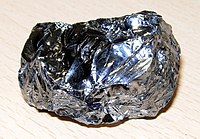
Photo from wikipedia
Abstract Recent analytical developments have made possible the determination of the isotopic composition of tin in igneous rocks. In order to establish a framework to interpret the mass-dependent tin isotopic… Click to show full abstract
Abstract Recent analytical developments have made possible the determination of the isotopic composition of tin in igneous rocks. In order to establish a framework to interpret the mass-dependent tin isotopic signatures of planetary materials, seven geologically-relevant silicate glasses (basalt, rhyolite, enstatite and anorthite glasses) were synthesized with moderate amounts of 119Sn (on the order of a weight percent). Redox conditions were controlled during sample synthesis to set the redox ratio (Sn2+/Sntot) from stannous (Sn2+) to stannic (Sn4+) glasses. The mean force constants of tin bonds in these glasses were determined by synchrotron nuclear resonant inelastic X-ray scattering (NRIXS) in order to determine the reduced isotopic partition function ratios (β-factors) of these glasses. Clues on the coordination chemistry and the valence state of tin in these glasses were also derived from synchrotron Mossbauer spectroscopy (SMS). The force constants of tin drastically increases from Sn2+-bearing to Sn4+-bearing glasses and varies significantly with the glass composition at a given redox state. The average coordination number of tin likely controls these variations with glass composition as suggested by SMS results. It is concluded that large isotope fractionation is expected between materials containing Sn2+ and Sn4+ respectively even at magmatic temperatures and that the coordination chemistry of tin in silicates strongly affect its isotope partitioning behavior. Our experimental data are finally used to interpret available Sn isotope data collected in terrestrial rocks. The incompatible behavior of Sn4+ in mantle minerals leads to a enrichment in heavy isotopes in mantle melts and to the depletion in heavy isotopes in solid residues of melting with a magnitude consistent with the isotope fractionation between Sn2+ and Sn4+ predicted by NRIXS data. Finally, we show that during fractional crystallization of basalt and considering the effect of tin coordination number in minerals and melts, the partitioning of Sn4+ into ilmenite leads to an enrichment in light isotopes in the residual melt.
Journal Title: Geochimica et Cosmochimica Acta
Year Published: 2020
Link to full text (if available)
Share on Social Media: Sign Up to like & get
recommendations!